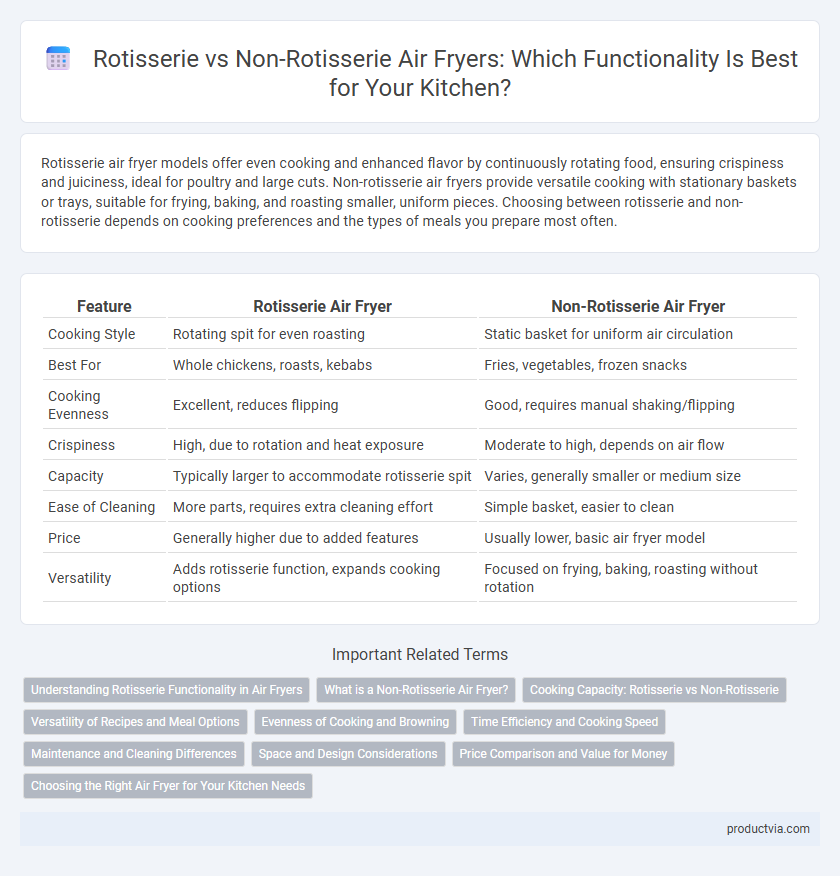Rotisserie air fryer models offer even cooking and enhanced flavor by continuously rotating food, ensuring crispiness and juiciness, ideal for poultry and large cuts. Non-rotisserie air fryers provide versatile cooking with stationary baskets or trays, suitable for frying, baking, and roasting smaller, uniform pieces. Choosing between rotisserie and non-rotisserie depends on cooking preferences and the types of meals you prepare most often.
Table of Comparison
| Feature | Rotisserie Air Fryer | Non-Rotisserie Air Fryer |
|---|---|---|
| Cooking Style | Rotating spit for even roasting | Static basket for uniform air circulation |
| Best For | Whole chickens, roasts, kebabs | Fries, vegetables, frozen snacks |
| Cooking Evenness | Excellent, reduces flipping | Good, requires manual shaking/flipping |
| Crispiness | High, due to rotation and heat exposure | Moderate to high, depends on air flow |
| Capacity | Typically larger to accommodate rotisserie spit | Varies, generally smaller or medium size |
| Ease of Cleaning | More parts, requires extra cleaning effort | Simple basket, easier to clean |
| Price | Generally higher due to added features | Usually lower, basic air fryer model |
| Versatility | Adds rotisserie function, expands cooking options | Focused on frying, baking, roasting without rotation |
Understanding Rotisserie Functionality in Air Fryers
Rotisserie functionality in air fryers enables even cooking by rotating food continuously, which helps achieve crispy exteriors and juicy interiors, especially for whole chickens and roasts. Non-rotisserie air fryers rely on stationary baskets and rapid air circulation to cook food but may not provide the same uniform browning or self-basting effects. Understanding this difference can help users select an air fryer model that best suits their cooking preferences and needs for various recipes.
What is a Non-Rotisserie Air Fryer?
A non-rotisserie air fryer uses rapid hot air circulation to cook food evenly without rotating it on a spit or skewer. It relies on a basket or tray where food is placed, allowing for versatile cooking options such as frying, baking, and roasting. Non-rotisserie air fryers are ideal for smaller portions or foods that do not require continuous turning for even cooking.
Cooking Capacity: Rotisserie vs Non-Rotisserie
Rotisserie air fryers typically offer greater cooking capacity by accommodating whole chickens or larger cuts of meat, evenly cooked through constant rotation. Non-rotisserie models usually have a smaller interior space optimized for batch cooking or single-layer food items, limiting the volume and type of food that can be prepared at once. Choosing between rotisserie and non-rotisserie air fryers depends on whether users prioritize cooking large, evenly roasted items or prefer versatile space for multiple smaller dishes.
Versatility of Recipes and Meal Options
Rotisserie air fryers offer enhanced versatility by enabling even cooking of whole poultry, roasts, and kebabs through continuous rotation, which ensures consistent browning and juiciness. Non-rotisserie air fryers excel in quickly preparing a variety of meals such as fries, vegetables, and frozen snacks with their static basket design, providing convenience for everyday cooking. Choosing between the two depends on whether the priority is diverse meal options with rotisserie cooking or efficient preparation of simpler, quick dishes.
Evenness of Cooking and Browning
Rotisserie air fryers provide superior evenness of cooking by continuously rotating food, ensuring uniform heat exposure and consistent browning on all sides. Non-rotisserie models rely on stationary placement and air circulation, which may cause uneven cooking or browning, especially for thicker cuts. The rotating mechanism in rotisserie units enhances caramelization and crispiness, making them ideal for roasting whole chickens or large cuts of meat.
Time Efficiency and Cooking Speed
Rotisserie air fryers offer enhanced time efficiency by evenly rotating food, ensuring faster and more uniform cooking compared to non-rotisserie models. Non-rotisserie air fryers rely on stationary placement and hot air circulation, which can result in longer cooking times and less consistent results. Choosing a rotisserie function significantly improves cooking speed for whole chickens, roasts, and kebabs.
Maintenance and Cleaning Differences
Rotisserie air fryers feature removable spit rods and drip trays that require thorough cleaning to prevent grease buildup, while non-rotisserie models typically have simpler baskets or trays that are dishwasher-safe for easier maintenance. The rotating mechanism in rotisserie units demands occasional lubrication and careful handling to avoid mechanical issues, contrasting with the straightforward cleaning routine of static basket designs. Regular upkeep of rotisserie components extends the appliance's lifespan but involves more detailed cleaning compared to non-rotisserie air fryers.
Space and Design Considerations
Rotisserie air fryers typically require more interior space to accommodate the rotating spit and larger cooking chamber, impacting countertop placement and overall footprint. Non-rotisserie models offer a more compact design, making them ideal for smaller kitchens with limited space, while providing flexible rack configurations for diverse cooking needs. Selecting between these designs involves balancing the desire for even cooking and versatility with spatial constraints and ease of storage.
Price Comparison and Value for Money
Rotisserie air fryers typically cost 20-30% more than non-rotisserie models, reflecting added features like motorized rotation and even cooking. Non-rotisserie air fryers offer good value for money with a lower price point, ideal for users prioritizing affordability and straightforward air frying. Investing in a rotisserie air fryer benefits those seeking enhanced versatility and premium results, justifying the higher initial cost through improved cooking performance.
Choosing the Right Air Fryer for Your Kitchen Needs
Rotisserie air fryers offer even cooking by continuously rotating food, ideal for roasting whole chickens and achieving crispy, golden skin. Non-rotisserie models provide versatile cooking options with faster cooking times and simpler designs, suitable for frying, baking, and reheating smaller portions. Selecting between rotisserie and non-rotisserie air fryers depends on your cooking preferences, kitchen space, and the types of meals you prepare regularly.
Rotisserie vs Non-rotisserie for air fryer functionality Infographic

 productvia.com
productvia.com